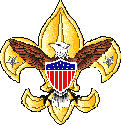| MERIT BADGES |
|
|
|
|
| Note: Eagle Required are in Italics |
"A"
American
Business
American Culture
American Heritage
American Labor
Animal Science
Archaeology
Archery
Architecture
Art
Astronomy
Athletics
Atomic Energy
Auto Mechanics
Aviation
"B"
Backpacking
Basketry
Bird Study
Bugling
"C"
Camping
Canoeing
Chemistry
Cinematography
Citizenship
Community*
Citizenship Nation*
Citizenship World*
Climbing
Coin Collecting
Collections
Communications*
Computers
Cooking
Crime Prevention
Cycling*
"D"
Dentistry
Disability Awareness
Dog Care
Drafting
"E"
Electricity
Electronics
Emergency
Preparedness**
Energy
Engineering
Entrepreneurship
Environmental
Science*
"F"
Family Life*
Farm Mechanics
Fingerprinting
Fire Safety
First Aid*
Fish & Wildlife Mgmt.
Fishing
Fly Fishing
Forestry
"G"
Gardening
Genealogy
Geology
Golf
Graphic Arts
"H"
Hiking
Home Repairs
Horsemanship
"I"
Indian Lore
Insect Studies
"J"
Journalism
"K"
"L"
Landscape Architecture
Law
Leatherwork
Lifesaving**
"M"
Mammal Study
Medicine
Metalwork
Model Design & Building
Motorboating
Music
"N"
Nature
"O"
Oceanography
Orienteering
"P"
Painting
Personal Fitness**
Personal Management*
Pets
Photography
Pioneering
Plant Science
Plumbing
Pottery
Public Health
Public Speaking
Pulp and Paper
"Q"
"R"
Radio
Railroading
Reading
Reptile & Amphibian Study
Rifle Shooting
Rowing
"S"
Safety
Salesmanship
Scholarship
Sculpture
Shotgun Shooting
Skating
Skiing
Small Boat Sailing
Soil & Water
Conservation
Space Exploration
Sports**
Stamp Collecting
Surveying
Swimming**
"T"
Textile
Theatre
Traffic Safety
Truck Transportation
"U"
"V"
Veterinary Medicine
"W"
Water Skiing
Weather
Whitewater
Wilderness Survival
Wood Carving
Woodwork
"X"
"Y"
"Z"
 Climbing
ClimbingRequirements 1999 |
- Show that you know first aid for injuries or illnesses that may occur during climbing activities, including hypothermia, blisters, sprains, snakebite, abrasions, fractures, and insect bites or stings.
- Identify the conditions that must exist before performing CPR on a person. Demonstrate proper technique in performing CPR using a training device approved by your counselor.
- Present yourself properly dressed for belaying, climbing, and rappelling (i.e., appropriate clothing, footwear, and a helmet; rapellers must wear gloves).
- Location. Do the following:
- Explain how the difficulty of climbs is classified, and apply classifications to the rock faces or walls where you will demonstrate your climbing skills.
- Explain the following: top-rope climbing, lead climbing, and bouldering.
- Evaluate the safety of a particular climbing area. Consider weather, visibility, the condition of the climbing surface, and any other environmental hazards.
- Determine how to summon aid to the climbing area in case of an emergency.
- Verbal signals. Explain the
importance of using verbal signals during every climb and rappel, and while
bouldering. With the help of the merit badge counselor or another Scout,
demonstrate the verbal signals used by each of the following:
- Climbers
- Rappellers
- Belayers
- Boulderers and their spotters
- Rope. Do the following:
- Describe the kind of rope acceptable for use in climbing and rappelling.
- Show how to examine a rope for signs of wear or damage.
- Discuss ways to prevent a rope from being damaged.
- Explain when and how a rope should be retired.
- Properly coil a rope.
- Knots. Demonstrate the ability to
tie each of the following knots. Give at least one example of how each knot is
used in belaying, climbing, or rappelling.
- Figure eight on a bight
- Figure eight follow-through
- Water knot
- Double fishermanıs knot (Grapevine knot)
- Harnesses. Correctly put on at least
ONE of the following:
- Commercially made climbing harness
- Tied harness
- Belaying. Do the following:
- Explain the importance of belaying every climber and rappeller.
- Belay three different climbers ascending a rock face or climbing wall.
- Belay three different rappellers descending a rock face or climbing wall.
- Climbing. Do the following:
- Show the correct way to tie into a belay rope.
- Climb at least three different routes on a rock face or climbing wall, demonstrating good technique and using verbal signals with a belayer.
- Rappelling. Do the following:
- Using carabiners and a rappel device, secure your climbing harness or tied harness to a rappel rope.
- Tie into a belay rope set up to protect rappellers.
- Rappel down three different rock faces or three rappel routes on a climbing wall. Use verbal signals to communicate with a belayer, and demonstrate good rappelling technique.
- Demonstrate ways to store rope, hardware, and other gear used for climbing, rappelling, and belaying.
|
||||||
Last Update May 15, 2023

.jpg)
